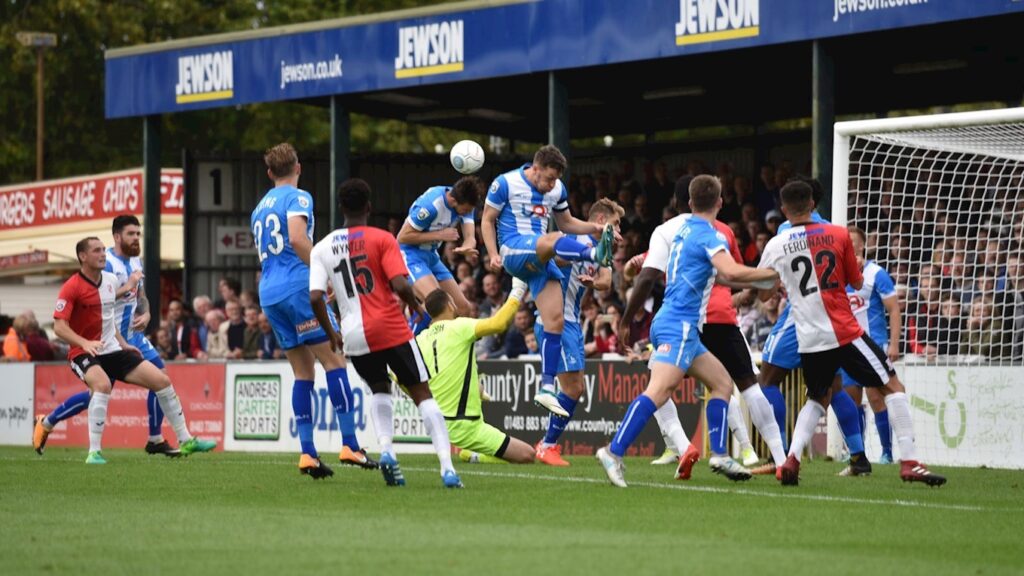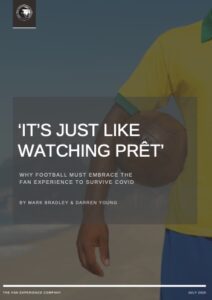And this is where Non-League Day comes in. Next March we’ll welcome it back after an enforced Covid-related hiatus. It is, of course, an opportunity to promote the huge community contribution made by small, often volunteer-run local community clubs and a chance for supporters of ‘higher league’ professional clubs to re-engage with football in its purest form.

Making Non-League Day Happen Weekly

Mark Bradley
@fanexperienceco
Mark works all over Europe helping associations, leagues and clubs to understand and improve fan engagement and their match day experience.
The Fan Experience Company was founded in 2005, and in 2019/20 they oversaw the assessment of over 350 games each season in 13 countries.
While much of the focus is on the return of fans to professional clubs right now, they’re all still here (though only just in some cases). However, the damage to non-league clubs was close to fatal. In this article, I want to set out how those precious community assets can not only survive, but thrive, based on a strategy of engagement.
From our work with the FA before Covid, the most common theme was sustainability: how to generate sufficient funds to allow the club to develop in a structured way. Investment in a 4G or 5G pitch and creating a community asset; successive promotions up through the pyramid and uncovering the next Jamie Vardy and inserting a sell-on clause are all obvious paths, but they’re not open to everyone. But what is often overlooked is the development of a growth strategy based on community engagement. Terms like ‘fan engagement’ abound these days, but what does that look like at non-league levels?
Before I describe the main components of this strategy, let’s first acknowledge some obstacles. Change does not come easy to football clubs. Cashless purchase is only now beginning to trickle down the professional pyramid when, for most of us, it’s been a subconscious expectation for more than a decade now. In fact, we recently undertook a fan experience assessment at an international match where the official supporter guide suggested that those using the official car parking services ‘should try to bring the right amount’. If you’re going to embark on the strategy I’m about to outline, prepare for some difficulty.
We also need to sow the seeds of belief too. While many non-league clubs struggle from time to time, it’s not exactly heartening to greet the programme seller (a key first impression for a new fan) and be told ‘this club is dying on its knees’ (as happened to us a few seasons back when groundhopping in Derbyshire (and no, it wasn’t Derby County). To paraphrase that positive mindset motto: if you think you can do it, you can. If you think you can’t, you won’t. We need to understand that one of the many negative outcomes of a subsistence or survival culture at a club is its impact on envisioning positive futures.
Another pre-requisite is an experienced and diverse skills base among the volunteers, for it is usually the case that organisations outside of football have more to show us than our own club’s past achievements. That word ‘volunteer’ will keep coming up too: an ability to inspire, recruit, develop and value the people who will do the ‘heavy lifting’ is fundamental to success.
However, one committed, relentless, stubborn volunteer can the difference between an era-defining uplift in facilities and a club’s demise. So, what are clubs doing? Which are creating links with local colleges and universities, where young students with a love of sport are looking for experiences that will help develop their business, marketing, media, communications and technology skills? For an example, look at how Ashton United has forged successful links with UCFB (the Football university).
Of course, the key principle underpinning any community engagement strategy is ‘valuing people’ and yet football has somehow managed to survive to this point by assuming everything else comes second to the importance of winning. Our work in Moldova (Europe’s poorest country) has faced this barrier. Fans generally don’t turn up to League games. They prefer European qualifying games. This culture has resulted from a preference of club owners to simply target 3rd or 4th place and to direct all funds to that aim.
The result is that, when we began our UEFA Grow Community Development project towards the end of 2019, there wasn’t a ‘fan experience’ to speak of: no refreshments, no entertainment off the pitch, nothing for kids and pretty poor toilets too. Remarkably, even though our project has happened almost entirely under the restrictions of the pandemic, attendances have doubled in just one year. Why? Because we have focused the national association, the league and the clubs on it: principally through the creation of a CDO at each club (Community Development Officer). Remember that ‘heavy lifting’ I mentioned earlier.
This is based on our previous experiences of driving growth through engagement and is formed on several key principles, including developing club identity, engaging and supporting the local community and converting the match day into a community celebration. We did the same in Estonia with similar results. Parnu Vaprus joined the project at the start of the season in which they were relegated to tier two and yet, in the two years since (without being promoted) they have broken their own attendance records, including setting a new home attendance record. Maybe it’s no coincidence that both countries have seen a club qualify for the group stage of UEFA competitions this season (Flora Tallinn and Sheriff Tiraspol).
So, what has this got to do with non-league football? Quite simply that the very same strategic principles apply. Let’s look at identity first. Warning: this isn’t about designing a new badge, but fundamentally challenging the club’s raison d’être and doing something about it. What would the locality lose if we weren’t here? What could we gain if we re-aligned our identity with themes and hopes closer to the hearts of our community?
Followers of our work will know of our love of Lewes FC – the first club in the world to pay its men’s and women’s players the same – and Bohemian FC – a club who, even during the pandemic, were setting new retail records with third shirts devoted to welcoming refugees and addressing homelessness. Both clubs, like most non-league clubs, are volunteer run. In their case, however, their function is not just to play good football and win things (which they rarely do), but to make lives better (albeit in different ways). In Moldova, where high levels of poverty mean that animal welfare is in crisis, one of our clubs is beginning to step up.
So, let’s ask ourselves what our club is for? Because if it is only to win football matches, then that considerably narrows our ability to attract and retain new match-attending fans.
Community engagement can happen in many ways: but as well as supporting local needs and / or celebrating local identity, it should also have the end game of getting people to come to matches. Many professional clubs miss this opportunity through running two separate businesses: the football club and the trust. At non-league levels we don’t have that luxury, so let’s ensure that everything points to Saturday afternoon.
Next, we must make sure that the people who come to check us out, come again. My buddy Julian Jenkins used to tell the story of friends who’d taken their kids to their first game at the local pro club, because they were putting a big ‘family day’ on. There was everything: funfair, magicians, entertainment, music, food: the lot. And, to top it off, it was only £20 for a family of four. Bingo!
The kids wanted to come back, naturally, but they were disappointed to find nothing happening at the next game. Plus, it was £50 for a family of four this time. Lesson learned? Of course, no non-league club has the budget to emulate the club in the anecdote, but the point is made. It is unlikely that the football alone will be sufficient to compel many new fans to return. Over 20 years of working in football (at every level, men’s and women’s, here and across Europe) is that, for first time fans, cost is a much bigger factor in getting them to their first game than it is to make them come back. For the latter, experience is always the key factor.
Non-League Day, founded by James Doe more than a decade ago, is now responsible for often doubling and tripling attendances, once a year, at grounds whose names you’ve never heard of. The Dripping Pan, The Moat Ground, The Nanpantan Sports Ground or the Plain Ham Ground (answers on a postcard …): all ringing with associations, characters and memories only known to the privileged few.
Now, while clubs always experience a spike in attendance at these fixtures, imagine if many of those how would it be if those ‘first timers’ came back? After all, the whole initiative wouldn’t be in place if it weren’t for the reasons to return: the freedom to walk around the pitch, to change ends at half time, to drink within view of the pitch, to see football played purely for the love of the game, to pop into the bar for the half time scores or, as once happened to us at North Greenford United, to notice all bar the two of us going into the social club half way through the second half to watch the Grand National. And there is much, much more.
So how do clubs use this extra injection of support to grow crowds more steadily and over a longer period?
To start with, our work has highlighted that, unlike many larger professional ones, our smaller clubs, by and large, have fewer challenges once the new fan passes through the turnstiles. It’s true; the smaller crowds often mean you can more clearly hear a rich array of cursing, along that entertaining spectrum from unimaginative to fantastically creative (for example, how does a South Derbyshire fan abuse a North Staffordshire rival player? Simply this ‘Sit down and eat your oatcakes, you tw*t!’
Joking apart, this can restrict a club’s ability to encourage parents to bring their kids along, but the bigger issue is getting people to the turnstiles in the first place. Thus, the challenges are less to do with ‘half time entertainment’ and more to do with strengthening the local profile of the club; promoting its differences and illustrating how it ‘gives back’. Since after all, if all you want is 90 minutes of football, you might prefer the type they play at the Hawthorns to the level you get at Tividale FC. Yet it’s amazing how many people now deeply involved in non-league football only began by trying it as an antidote to watching the elite.
When it comes to assessing fan experiences at non-league football, we see the same ‘blind spot’ up and down the land: a failure to consider the needs of the ‘first time fan’. The more we assume, the less opportunities we must extend and diversify our reach. Contrast that with the club that has a ‘first time fan’ page: selling its story, its relevance and value to the community and the fantastic range of refreshments it offers, while showing people where to park, when to arrive and what there is for their kids will be the ‘cherry on the cake’. In this respect, we loved the Prescot Cables experience: there are so many reasons to go.
As anyone in grass roots football will tell you, everything must be fought for: every penny, every young emerging player, every grant, every penny of facilities funding and every devoted supporter. And yet next March, very little effort will be needed. New fans will be flooding in through your turnstiles and you’ll likely get the biggest crowd since the pandemic.
So why not use this as a catalyst for recognising that if we want sustainable growth, we must start to think and behave differently.
Want to read more by The Fan Experience Company?
Our white paper looks at the ways in which football clubs can get the right balance between safety and a great experience.
© The Fan Experience Company 2020

